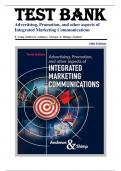Test bank
R
Advertising, Promotion, and other aspects of
Integrated Marketing Communications
U
J. Craig Andrews (Author), Terence A. Shimp (Author)
E
10th Edition
S S
I
O
N
N
O
C
E D
, MEDCONNOISSEURLIBRARIES.COM
Test Bank for Advertising, Promotion, and other aspects
of Integrated Marketing Communications, 10th Edition,
R
J. Craig Andrews, Terence A. Shim
Chapter 1— An Overview of Integrated Marketing
U
Communications
E
TRUE/FALSE
1. Marketing communications play an important role for all
companies.
S
ANS: T S PTS: 1
2. According to a recent study, integrated marketing communications is seldom employed by business-to-
business marketers.
I
ANS: F PTS: 1 O
3. The marketing communications component of the marketing mix has decreased dramatically in
importance in recent decades. N
ANS: F PTS: 1
4. Marketing and communications are virtually inseparable.
N
ANS: T PTS: 1
O
5. The use of marketing communications is not appropriate for organizations delivering not-for-profit
services.
ANS: F PTS: 1 C
6. Most marketing communications occur at the brand level.
ANS: T PTS: 1
D
7. The term brand is a convenient (and appropriate) label for describing any object of concerted
marketing efforts.
ANS: T PTS: 1
E
8. Brands perform a critical strategic role by providing a key means for differentiating one company’s
offering from competitive brands.
ANS: T PTS: 1
9. Many companies treat the various communication elements, such as advertising, sales promotions,
public relations, and so on, as virtually separate activities rather than integrated tools that work
together to achieve a common goal.
MEDCONNOISSEURLIBRARIES.COM
, MEDCONNOISSEURLIBRARIES.COM
ANS: T PTS: 1
10. Interactive marketing communications, or simply IMC, is the philosophy and practice of carefully
R coordinating a brand’s sundry marketing communications elements.
U ANS: F PTS: 1
11. One reason firms have not practiced IMC is because different units within organizations have
specialized in separate aspects of marketing communications.
ANS: T PTS: 1
E
12. One reason firms have not practiced IMC is because outside suppliers, such as advertising, public
relations, and promotion agencies, have been reluctant to broaden their function beyond the one aspect
S
of marketing communications in which they have developed expertise and built their reputations.
ANS: T PTS: 1
S
13. In reality, IMC is little more than a management fad that is short lived.
I
ANS: F PTS: 1 O
14. Novice managers are more likely than experienced managers to practice IMC.
ANS: F PTS: 1 N
15. By closely integrating multiple communication tools and media, brand managers achieve duplicity,
which means multiple methods in combination with one another yield more positive communication
results than do the tools used individually.
ANS: F PTS: 1
N
O
16. The integrated marketing communication process starts by determining the strengths and weaknesses
of the marketer.
ANS: F PTS: 1
C
17. The IMC approach uses the “inside-out” approach in identifying communication vehicles.
ANS: F PTS: 1
D
18. The use of integrated marketing communications is restricted to the mass media.
E
ANS: F PTS: 1
19. The terms touch point and contact are used interchangeably to mean any message medium capable of
reaching target customers and presenting the brand in a favorable light.
ANS: T PTS: 1
20. Coordination of messages and media is absolutely critical to achieving a strong and unified brand
image and moving consumers to action.
ANS: T PTS: 1
MEDCONNOISSEURLIBRARIES.COM
, MEDCONNOISSEURLIBRARIES.COM
21. A positioning statement is the key idea that encapsulates what a brand is intended to stand for in its
target market’s mind.
R ANS: T PTS: 1
22. Successful marketing communication requires building relationships between brands and their
U consumers/customers.
ANS: T PTS: 1
23. One thing that has not changed in marketing communication practices is the dependence on mass
E media advertising.
ANS: F PTS: 1
S
24. The mixture of communications elements and the determination of messages, media, and momentum
are all fundamental decisions in the brand-level marcom decision process.
ANS: F
I S PTS: 1
25. The various types of brand-level marcom decisions include fundamental decisions and implementation
O
decisions.
ANS: T PTS: 1
N
26. The objective of marketing communications is to enhance brand equity as a means of moving
customers to favorable action toward the brand.
ANS: T PTS: 1
N
27. A brand has no equity if consumers are unfamiliar with it.
ANS: T PTS: 1
O
28. Selection of target segments is a critical step toward effective and efficient marketing communications.
ANS: T PTS: 1
C
29. A brand’s name is the central idea that encapsulates a brand’s meaning and distinctiveness relative to
D
competitive brands in the product category.
ANS: F PTS: 1 E
30. The fundament decisions in the marcom decision process are conceptual and strategic, and the
implementation decisions are practical and tactical.
ANS: T PTS: 1
31. There is an optimum mixture of expenditures between advertising and promotion that can be
determined using computer models.
ANS: F PTS: 1
32. Systematic decision making requires that message content be dictated primarily by the media vehicle
used to reach the target audience.
MEDCONNOISSEURLIBRARIES.COM




